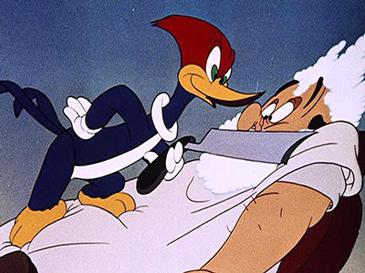The Barber of Seville was the first cartoon to feature a more streamlined character design for Woody Woodpecker, courtesy of veteran animator Emery Hawkins and art director Art Heinemann. In prior shorts, Woody had had a more grotesque appearance, including buck teeth, a receding chin, and thick stubby legs. Heinemann removed these features, and restructured Woody's body to conform to the modern animation standards in use for characters such as those appearing in Disney and Warner Bros cartoons.


In tandem with the use of the new Woody design, The Barber of Seville was the first Woody Woodpecker cartoon to use the standardized opening title card, animated by Hawkins, featuring Woody popping out of a log, asking "Guess Who?!", and delivering his trademark laugh. The audio for this opening sequence is lifted from Woody's first starring appearance in the 1941 cartoon Woody Woodpecker, in which Woody was voiced by Mel Blanc. Ben Hardaway, also the co-storyman on Barber of Seville, provides Woody's speaking voice for the cartoon proper, with an unidentified singer performing as Woody's singing voice.

The Barber of Seville is noted for its uses of speed, timing, and music synchronization. During the shaving of the second client, several shots are presented in rapid succession, some lasting only one-fourth of a second. Woody's demeanor and attitude are designed to match the music, during the famous "Figaro" portion of the tune, Woody splits into three, then four, then five instances of himself, in less than two seconds of screen time. Director Shamus Culhane later called The Barber of Seville "one of his most satisfying achievements as a director".
By 1944, Rossini's opera was a staple of American cartoon humor, with a noted earlier use in the Looney Tunes short Notes to You (1941) starring Porky Pig. Later cartoons to parody Rossini's music include Rabbit of Seville (Warner Bros.) and Magical Maestro (MGM). In 1994, The Barber of Seville was voted as number forty-three of The 50 Greatest Cartoons of all time, as voted by 1000 animation professionals and edited by Jerry Beck.
Rabbit of Seville
Rabbit of Seville is a 1949 Warner Bros. Looney Tunes theatrical cartoon short released in 1950. It was directed by Chuck Jones and written by Michael Maltese.
The cartoon, in a plotline reminiscent of Stage Door Cartoon, features Bugs Bunny being chased by Elmer Fudd into the stage door of the Hollywood Bowl, whereupon Bugs tricks Elmer into going onstage, and participating in a break-neck operatic production of their chase punctuated with gags and accompanied by musical arrangements by Carl Stalling, focusing on Rossini's overture to The Barber of Seville.
Stalling's arrangement is remarkable in that the overture's basic structure is kept relatively intact; some repeated passages are removed and the overall piece is conducted at a faster tempo to accommodate the cartoon's standard running length.
In 1994 it was voted #12 of the 50 Greatest Cartoons of all time by members of the animation field.

The scene where Bugs and Elmer try to outdo each other with bigger weapons is repeated in an episode of Disney's Darkwing Duck when Darkwing-who has been turned in a evil twin copy of Negaduck-and the real Negaduck also try to outdo the each other with bigger weapons.

The ABC airing of this cartoon mutes out some of the sound effects of Elmer shooting in the beginning of the cartoon. The shot of Bugs slashing Elmer's face with a razor was also cut by replacing it with a cropped shot of Bugs holding a mirror (which appeared after Elmer got slashed) and grimacing in disgust while the sound of the slashing played as normal.Even though Cartoon Network's airings of this short was uncut, it was usually time-compressed, meaning that it was sped-up to shorten the running time.

No comments:
Post a Comment